13. Wehgetan
Our favourite pub, Schwabinger 7, had just moved to a new place. There were still a few things not right – like a dangerous arrangement of some furniture and the lack of air conditioning.
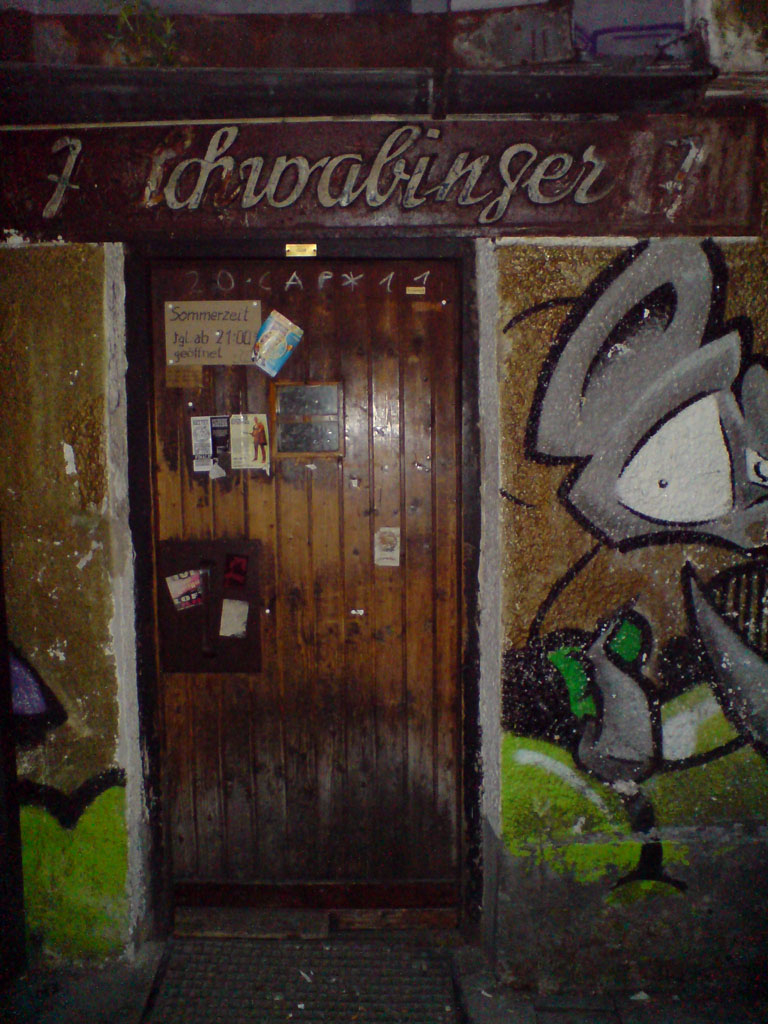
Die alte Schwasi - those were the days...
One night, Jenny would return from the laides’ (I’m using that term although “ladies’ ” is perhaps not what many guest would believe is the right word for that in tha hangout), complaining “Ich hab’ mir am Kondomautomaten wehgetan!” (I hurt myself on the condom vending machine).
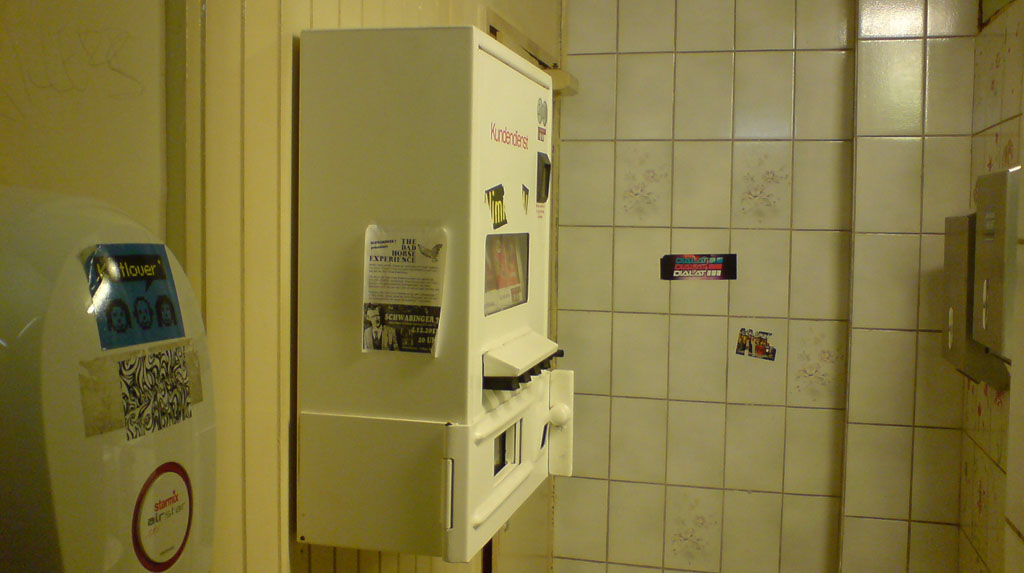
Jenny provided this shot of the corpus delicti
With LaBrassBanda running in the background, this quickly turned into a singalong, which I would afterwards turn into a quick arrangement on my Sirius synth and test-drive at an experimental ambient music festival (go figure). The experience I gained: even if it’s experimental and ambient, you still can get people to sing along to a ska tune, if the festival is in Italy.

Jason and Susi singing "Wehgetan!"
Now I had a composition of a song, I had a live recording clocking in at 4:50 with audience singalong, and I had a project where the maximum allowed song length was 90 seconds. What to do?
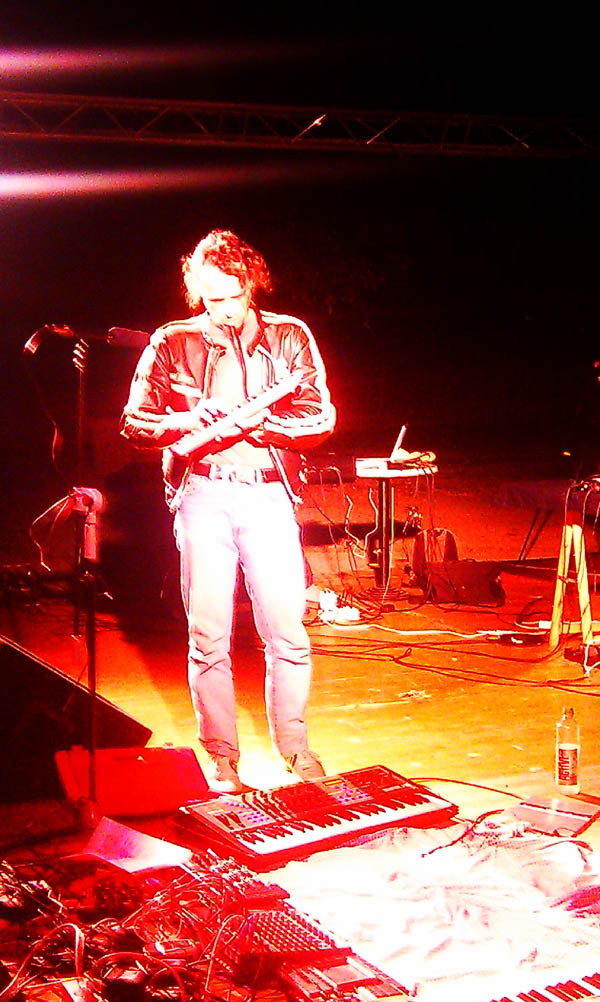
Mops Moser provided this great shot of me doing the dub
After some to and fro, I made up my mind to completely rearrange and -record the track. The arpeggiated synth riff is now played by not one but three synths (and uses a rather tricky arrangement during the melodica section), the theme in the beginning is stated by six trombones, drums are done by Linn9000 samples, with the added beauty of an acoustic hihat recorded by Guido Kremer. There’s still two melodica solos, there’s still the audience singing along (using the tracks from firenze), and there’s even cheesy harmony vocals in the coda.
Synth-wise, it’s a combo of Sirius, DSI Evolver and Virus for the synth riff, alternating Sirius and Virus for the off-beat organ, and Trilogy for the synth bass. There’s also an additional Battery2 acoustic kit mixed in, there’s a electroharmonix Stereo Memory Man with Hazari and a Lexicon Vortex (vintage!) on the melodica, and the Virus arpeggiated part is at times sent through an Eclipse…
This is the most complex track on the album as DAWs count it with more than 80 tracks, and also the most groovy yet cheesy one. Get up and dance, folks!
14. The Usual Bavarian Approach to Electronics
Back when I got my first proper melodica (a vintage 36-key Hohner Professional with a wooden body, which Benedikt Eppelsheim, in his day job god of saxophone making, would generously fix for me), I decided to record a quick melodica track: a guitar groove went onto the old Electrix Repeater, a factory patch from the Roland MC505 was synced to it, and I played a short melodica line over it, not without adding some Eventide Eclipse effect. This had since then been my main ringtone, and as such was called just that.
For the #secretalbum, this track was rerecorded. I used a setup with two Beyer M160 to get the melodica, threw out the guitar tracks, and copied the MC505 parts to Cubase, and had them played by a Battery 2 trapset (with added phaser for the crash cymbal) and Trilogy for the sine wave bass part. The guitar was disposed of, the Eventide Eclipse was kept.

Rhys Anslow
Now that would even sound nicer with a proper bass guitar – enter Rhys Anslow. Interestingly, while I sent him the score for the bass guitar, he decided to ignore it, and play the first note in each phrase (which on the mockup recording was heavily ducked by the bass drum) as two notes – works fine for me!
Some people ask me where I get the ideas for my song titles. In this case, it’s part of a sentence from “Gravity’s Rainbow” by Thomas Pynchon. Which is not only a great book, it’s also an example where the German translation of the title (“Die Enden der Parabel”) is actually better than the original (this refers only to the title, not to the novel proper).
15. Sid’s Impeccable Design
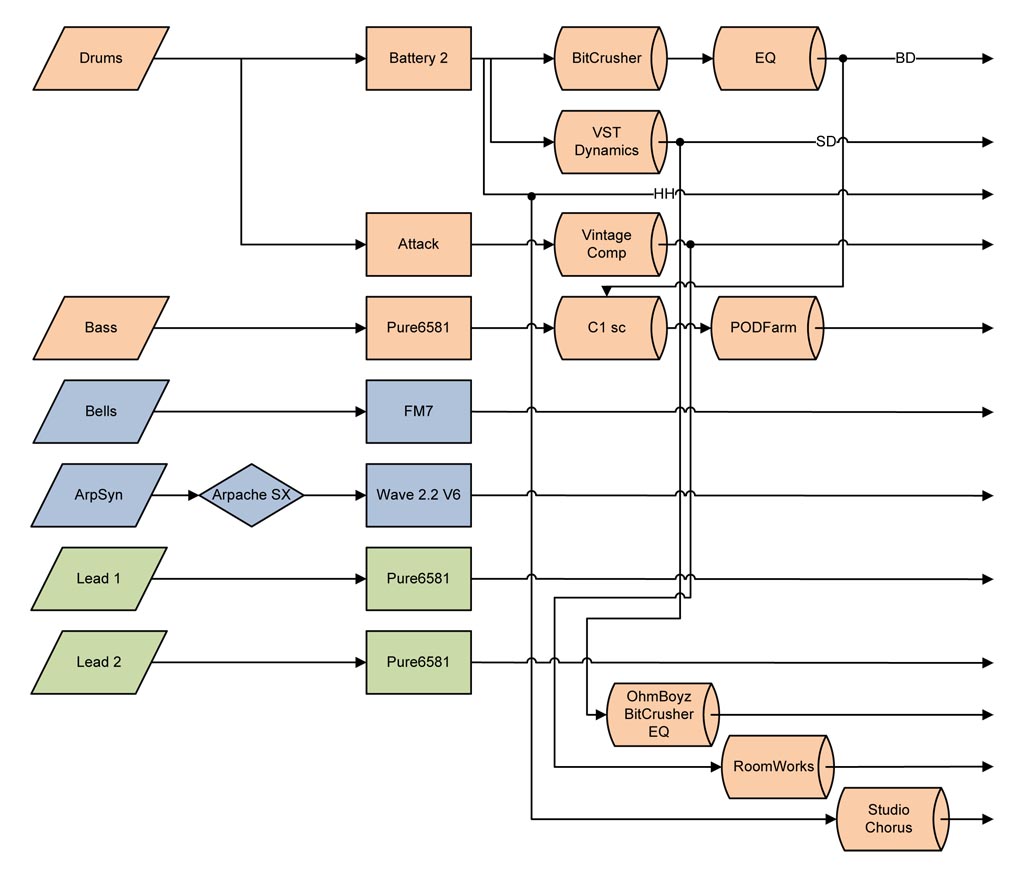 Every conversation about chiptune will sooner or later move in the direction of the Sound Interface Device, or SID for short. The MOS Technology 6581 is believed to be one of the reasons behind the huge success of the Commodore C64 home computer, and that for a reason: back in the day, the SID brought a big step forward what computers could do music-wise with their integrated hardware.
Every conversation about chiptune will sooner or later move in the direction of the Sound Interface Device, or SID for short. The MOS Technology 6581 is believed to be one of the reasons behind the huge success of the Commodore C64 home computer, and that for a reason: back in the day, the SID brought a big step forward what computers could do music-wise with their integrated hardware.
The recursive-actronym-titled Sid’s Impeccable Design makes use of three instances of the Pure6581 VST (a free 6581 softsynth) for the two lead voices and the bass, plus a NI FM7 (synth pad in the A and A’ section) and a PPG Wave 2.2 VST by Hermann Seib (arpeggiated synth part in B section, driven by the Arpache SX). Drums are the heavy snare from Waldorf’s Attack, plus all the lofi drums which are 6581 samples loaded into Battery 2.
Musically, I enjoy this track a lot – mainly because it packs a full-blown composition into a format which is just 26 seconds in length if you subtract the trailing releases at the end:
We start off with a call-and-response theme in the first lead synth and the synth bass for the A section, which gets repeated with small changes. We move into the parallel tonic in the B part – or do we? – before harmonies under the second theme bring us back to a repeated version of the A section; this time, however, the call-and-response theme starts with an upbeat, before we move into the coda for the second half of A’ and end with a tierce Picardie. Fun!
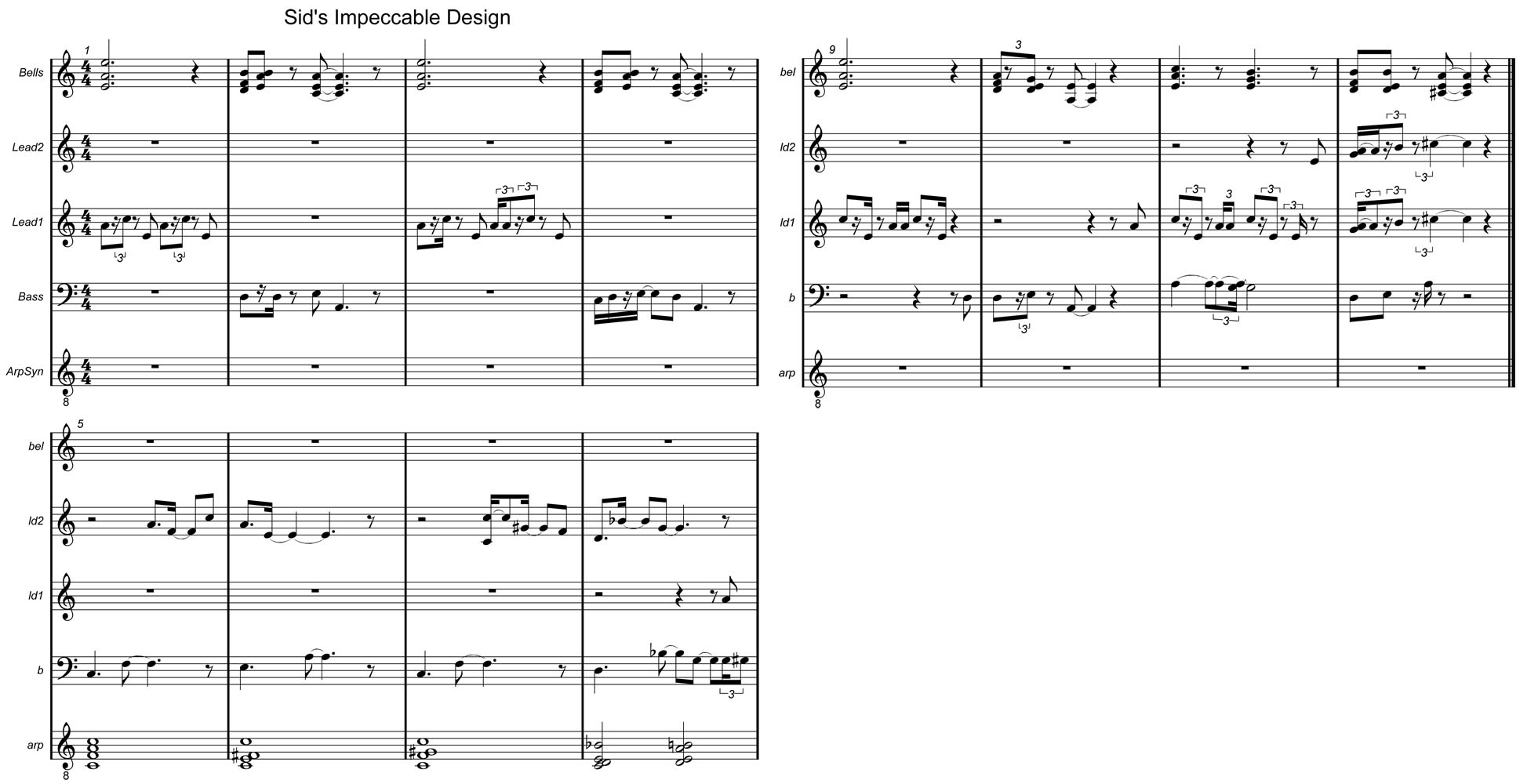
16. Verschluckbare Kleinteile
Since Wolfi Schlickhorn and I first met some 25 years ago at a party where the group “Poets of Rhythm” was playing and I asked him rather rudely why a obviously jazz-oriented guy like him would play bullshit like that, we’ve been in contact, musically and otherwise. I had a brief almost-stint with the Poets, he would play on my JANUS album, I was a founding member of his Express Brass Band, and many more fun things.
Let me just start the description of this track by stating that Wolfi plays a stunningly beautiful soprano saxophone part on this one (on my soprano saxphone, on my mouthpiece and using my reeds, because Wolfi usually plays rather “un-nice” sax parts, which makes his accomplishment all the more impressive).

Wolfi, not playing the soprano sax
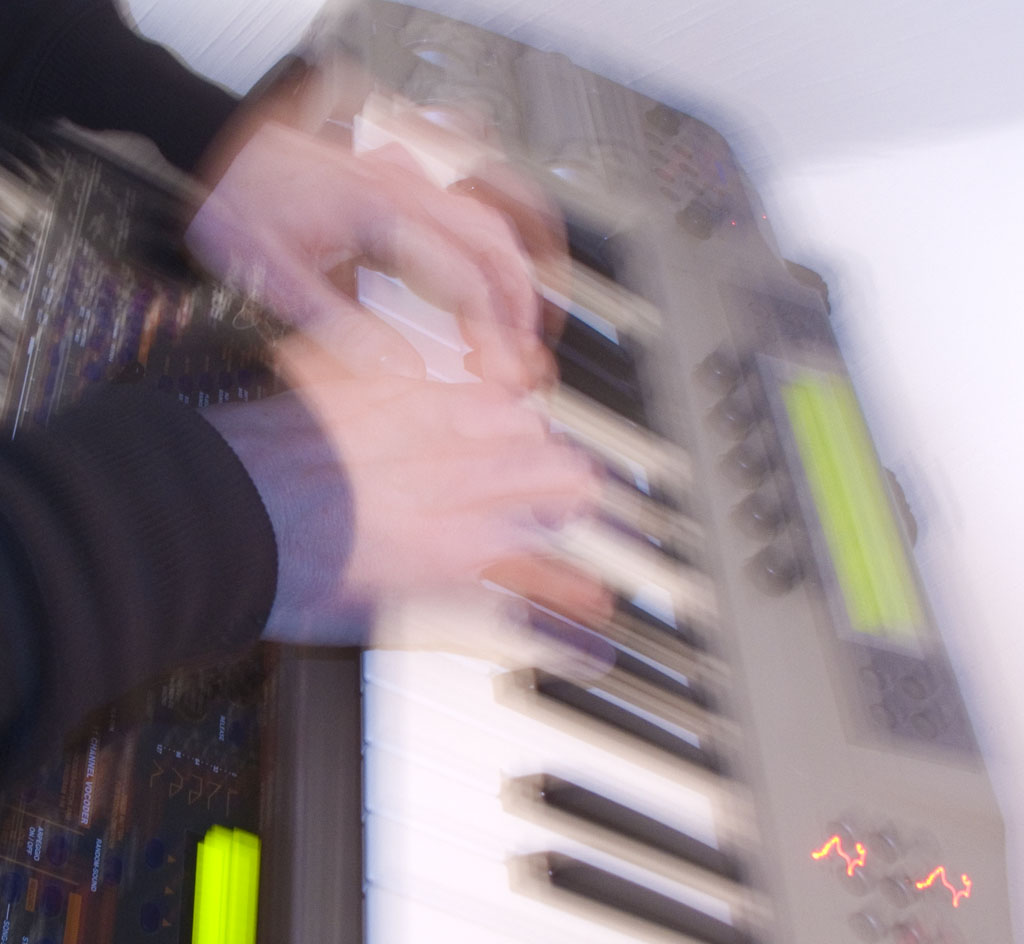
Moinho dubbing the Prophecy part
It’s a track with soprano saxophone and synthesizers (again, lots of them), and while this track also has a lot to offer regarding the composition and the use of synthesizers, this is not what I want to talk about at great length. There’s lots of them synthesizers (if you must know, Yamaha FS1R, NI FM7, Kurzweil K2600XS, NI B4, Wave PPG 2.2, NI Absynth and Halion), and at one point, a Korg Prophecy doubles the soprano sax, hidden in the mix so you almost cannot hear it…but all in all, this is about Wolfi’s soprano saxophone lead.
A great way to close the album. Thank you, Wolfi!

